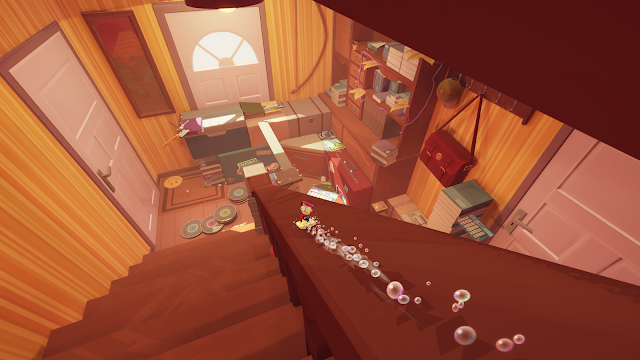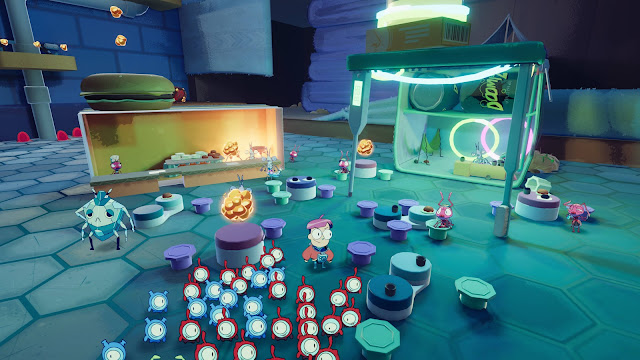Towards the end of 2022, I was trying to think of any games that I had wanted to write about, but just hadn’t gotten around to. It felt like things got a little backed up in my games writing last year, between some personal life delays, writers block on the Neon White article, and my non-games writing (like baseball and playlists) just taking up more time than anticipated. I might still end up writing a little more about games that I played last year (especially if playing them bled into this year), but at the start of 2023, when I thought about everything I played over the last twelve months and any lingering thoughts I had on them, there was one game that I kept returning to.
For a while, though, I wasn’t actually sure exactly what I wanted to say about Tinykin. I really enjoyed it, but there are only so many ways that you can say variations of “it’s good” and “I like it” before a review becomes boring, and I was a little busy sorting through other thoughts to pull together more than that. But over time I kept thinking about it, and I eventually realized that I did have a little bit more to say than just basic praise!
So, let’s start at the top: Tinykin is a 2022 3D platformer from developers Splashteam. It comes with a pretty simple pitch: what if Pikmin was a collect-a-thon platformer instead of a real-time strategy game? As far as basic crossover pitches go for a game idea, that one feels like it has a lot of promise; and it turns out, that’s pretty much dead-on! Of course, like any good cross-pollination of ideas, there are a lot of things that can’t be carried over one-to-one, and I think that Tinykin nails those elements in a way that gives it a lot of its own character and makes it even better than its simplistic idea sounds.
It starts at the beginning, really; protagonist Milo is a small person who finds himself stuck on an Earth that’s much too big for him. Unlike the protagonists of Pikmin, though, Milo is a scientist, searching for the origins of his people and planet. And his search strands him not outdoors, but in a house that looks stuck sometime in the 1990s, with VHS tapes and dated appliances everywhere. And inside, he finds these small creatures, the titular Tinykin, who are drawn to him; as you might have guessed from the Pikmin comparison, each variation has special abilities that he can make use of.
Oh, and like Pikmin, there are also bugs, distinct from your little helpers. Except Tinykin decides to frame itself entirely around exploring rather than keep any combat, so rather than being large monsters for you to take down, they’re all the same size as Milo. Also, they’ve built an advanced society that sprawls across the House, complete with agriculture, amusement parks, music, religion, parties, and fermented nectar drinks (which get described in terms that we’d expect for wines or craft beers). It really is an entire world you get to explore here, even if the building blocks are mostly just household items.
And not only that, but it’s a very cute and creative world you get to explore! Like, the big idea of “a society built by bugs” is already pretty great, but Splashteam’s execution here is just phenomenal! Everything, from the character sprites (everyone is an animated flat image with depth, similar to Demon Turf or Heaven’s Vault) to the everyday objects lying around these vibrant, cartoon-y landscapes looks are just so appealing to look at.
And sure, Splashteam is hardly the first group to design a video game world around the idea of “being small in a regularly-sized world”, but they put so much detail and effort in that it stands out. Every object is very immediately visually clear and distinct in both what its platforming purpose is, and what it originally was before being repurposed by the insects as architecture. There’s detail in the designs, wear and use around the edges, a sense of grandeur upon seeing large furniture as it looms over the scene… It really is just the perfect execution of this trope, especially given the game’s clean, colorful, animated art style.
It also helps that the ideas within the levels are a lot of fun! There’s always some small story built into the center of them, which gets you exploring around most of the level, usually something around resolving a dispute within bug society so they’ll entrust you with that level’s Big Collectible.
The first few levels are pretty stock settings for this type of story: a living room that’s been transformed into a town square (complete with a cardboard cathedral in the center) and a greenhouse that’s become a little overgrown. From there, they actually get more interesting, a nice twist compared to the number of modern games that put all their best ideas up front.
There’s a pair of connected bathroom resorts, one of which needs to restart their constant party, which is a funny bit. You get a second trip through the tutorial level, opening up what’s available with your new abilities; I always love when games include backtracking to very early levels in a way that completely recontextualizes them. And then there are the two best levels to close things out, the kitchen (which has been transformed into the house’s farmlands, with the local farming village in disarray) and the bedroom amusement park, both of which overload you with things to see and do. It also helps that it’s a short and sweet game of highly-polished moments, something you can take in over the course of a week’s evenings or a long weekend.
The design side of the equation is all rock-solid, so it helps that the gameplay side of things matches it to take the experience to the next level. As it turns out, a lot of Pikmin’s ideas translate very well to the 3D collectathon format with the right adjustments, and in cool ways that build upon themselves.
Each new room of the house that you explore will introduce you to a new color of Tinykin, each with its own abilities that will allow you to overcome more of the room’s obstacles. Their ability will in some way scale, meaning that the more Tinykin that you find, the more of the level that opens up to you, making the Tinykin both your new ability and one of the level’s collectables. It gives the game worlds this wonderful unfolding feeling, seeing areas early on that you could reach if only you had a few more Tinykin under your command, then returning later to open them up.
And of course, in traditional 3D Platformer Collectathon fashion, none of the central challenges of the level will require that you find every little creature. But you’ll need a healthy percent of them to beat the level anyway, and exploring the levels is usually fun enough on its own. So once you finish up the main quests, you’ll probably be close enough to to finding them all and curious enough about what you might be missing that you might as well look for the final stragglers. Like I said, it’s a well-worn standard of the genre, but I think Tinykin has polished this part of the game design pretty thoroughly!
Also, rather critically, most of the abilities that the Tinykin grant you aren’t movement abilities, which kind of surprised me going in; most of them are related to interacting with things in the level, like destroying obstacles or moving large items. That means the game can instead reward you with most of the movement options right away, which ends up making the game all that much smoother. Instead of plodding around until you get a higher jump or a fast-move option or something, you get it right out of the gate, meaning you can start zipping around and climbing things more or less from the beginning. 
That in turn really helps to emphasize how tight and smooth Tinykin’s mechanics are. Your biggest movement ability is a soapbar surfboard that you’re given early in the game; it’s already pretty intuitive to pick up, but with a little trial-and-error, you’ll be able to build and keep momentum like a pro. That knowledge, plus a working idea of the levels’ layouts, will have you zipping around in short order, which means that backtracking to deal with something that you found earlier across the map is basically never an issue. Once you know the map, you’re never more than a few rapid slides and jumps away from things.
If there’s a downside to their approach to abilities and navigation, it’s that each level is pretty self-contained. Each world limits you to just the Tinykin that you find in a level, with the only ability that you carry with you being the soapboard and the bubbles you can use to float across gaps (each bubble granting you longer air time). You might be returning to each room to search for the last few collectables, but outside of a small number of things aided by a longer hover, you can come pretty close to 100%-ing each world as you reach it.
I’m kind of split on this decision, or at least, I was for a little while. Like, on the one hand, unlocking more things after going to later levels sounds interesting if you can think of the right puzzles and obstacles to insert. And the game already has shades of this idea, with how levels unfurl as you find Tinykin, or getting to return to the tutorial level and explore it fully later.
On the other hand, it’s a nice idea in the abstract that can be a difficult thing to balance well in practice. What if a later ability completely invalidates an earlier challenge, making it trivial to overcome? Or if you make each ability completely distinct, what use is an obstacle or puzzle if it just sits there staring at you for three levels, just waiting for you to get the right Tinykin later and come back? Given all of that… I’m pretty happy appreciating how well Tinykin turned out. Maybe they can revisit the more complicated ideas in a sequel, now that they have a whole game under their belt?
Granted, if they want to move on to something else next, I’d also be okay with that! Really, Tinykin is kind of a perfect little game, a cute and fun 3D platformer to explore, without any real weak spot. If they want to build on that in some way next time, I’d be thrilled. But even if they decide to move on and try something else, I’d be excited to try that as well; watching them translate well-worn ideas and mechanics into completely new contexts this successfully gives me confidence in whatever direction they decide to go next.





No comments:
Post a Comment